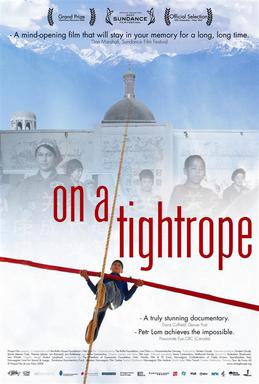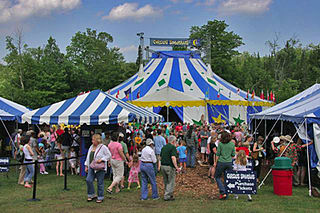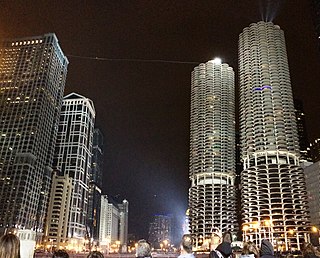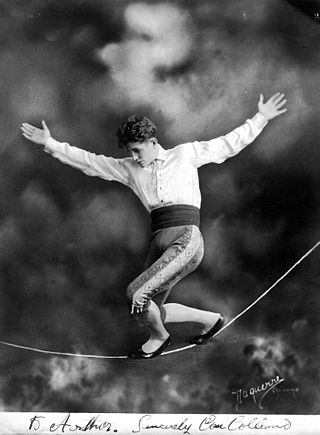
Niagara Falls is a group of three waterfalls at the southern end of Niagara Gorge, spanning the border between the province of Ontario in Canada and the state of New York in the United States. The largest of the three is Horseshoe Falls, which straddles the international border of the two countries. It is also known as the Canadian Falls. The smaller American Falls and Bridal Veil Falls lie within the United States. Bridal Veil Falls is separated from Horseshoe Falls by Goat Island and from American Falls by Luna Island, with both islands situated in New York.

Karl Wallenda was a German-American high wire artist. He was the founder of The Flying Wallendas, a daredevil circus troupe whose members performed dangerous stunts far above the ground, often without a safety net.

Charles Blondin was a French tightrope walker and acrobat. He toured the United States and was known for crossing the 1,100 ft (340 m) Niagara Gorge on a tightrope.
Jade Kindar-Martin is an American highwire walker and circus performer.

Philippe Petit is a French highwire artist who gained fame for his unauthorized highwire walks between the towers of Notre-Dame Cathedral in Paris in 1971 and of Sydney Harbour Bridge in 1973, as well as between the Twin Towers of the World Trade Center in New York City on the morning of 7 August 1974. For his unauthorized feat 400 metres above the ground – which he referred to as "le coup" – Petit had gathered together a team consisting of two of his closest, childhood friends from France joined by four recruited Americans plus a seventh comrade of Petit's. The group spent many months collaborating in detailed preparation, travelling to the World Trade Center multiple times, building an "outdoor" scale model of the roofs of both buildings, brainstorming and theorizing ways to bypass security, how to transport the hundreds of pounds of necessary materials from the street level up 104 stairs, and subsequently rigging the wire Petit would ultimately need for his walk. In spite of multiple obstacles, and a rescheduling from an earlier date in May of that same year, Petit and his team successfully secured the placement of his rigging; a 200-kilogram (440-pound) custom-made "walking wire", two "cavaletti" guide wires, plus a 8-metre (30-foot) long, 25-kilogram (55-pound) balancing pole. Despite NYPD intervening, Petit performed for 45 minutes, making eight passes along the wire. The act was considered to be not only an incredible performance of acrobatic skill and artistry, but perhaps even moreso, an ingenious feat of modern-day engineering. Upon completing his 45-minute, eight pass walk, Petit and Heckel were both arrested, charged with the crimes of Trespassing and Disorderly Persons, and forced to submit to psychiatric evaluations before being released. Petit's charges were ultimately dismissed after he agreed to perform on camera before a small group of children. Heckel was subsequently expelled from the United States. Petit would later be issued a "Lifetime Pass" granting him free admission to the WTC Observation Deck. Petit's wire-walk earned him a Guinness Book of Records for the highest wire-crossing without the use of a net or other type of safety tether, 1350' above ground. .

Slacklining is walking, running or balancing along a suspended length of flat webbing that is tensioned between two anchors. Slacklining is similar to slack rope walking and tightrope walking. Slacklines differ from tightwires and tightropes in the type of material used and the amount of tension applied during use. Slacklines are tensioned significantly less than tightropes or tightwires in order to create a dynamic line which will stretch and bounce like a long and narrow trampoline. Tension can be adjusted to suit the user, and different webbing may be used in various circumstances.
The Flying Wallendas is a circus act and group of daredevil stunt performers who perform highwire acts without a safety net. They were first known as The Great Wallendas, but the current name was coined by the press in the 1940s and has stayed since.

Stephen Peer (1840-1887) was a tightrope walker who, though he completed the feat successfully many times, fell to his death while walking a tightrope over Niagara Falls.

On a Tightrope (2007) is a documentary film by Petr Lom, co-produced by Piraya Film and Lom Films, in cooperation with the Rafto Foundation for Human Rights.

Circus Smirkus is a non-profit, award-winning, international youth circus founded in 1987 by Rob Mermin. Based in Greensboro, Vermont, the mission of Circus Smirkus is to promote the skills, culture and traditions of the traveling circus and to inspire youth to engage in the circus arts.

William Leonard Hunt, also known by the stage name The Great Farini, was a well-known nineteenth- and early twentieth-century Canadian funambulist, entertainment promoter and inventor, as well as the first known white man to cross the Kalahari Desert on foot and survive. He also published under the name Guillermo Antonio Farini.

Maria Spelterini was an Italian tightrope walker who was the only woman to cross the Niagara gorge on a tightrope, which she did on July 8, 1876 as part of a celebration of the U.S. Centennial. She used two and a quarter inch (57 mm) wire and crossed just north of the lower suspension bridge. She crossed again on July 12, 1876, this time wearing peach baskets strapped to her feet. She crossed blindfolded on July 19, and on July 22 she crossed with her ankles and wrists manacled. On July 27, 1876, she made her last trip across the Niagara Gorge on a tightrope.

Nikolas Wallenda is an American acrobat, aerialist, daredevil, high wire artist, and author. He is known for his high-wire performances without a safety net. He holds 11 Guinness World Records for various acrobatic feats, and is best known as the first person to walk a tightrope stretched directly over Niagara Falls. Wallenda walked 1,800 feet (550 m) on a steel cable over Masaya Volcano in Nicaragua, his longest walk, on March 4, 2020.

Henri L'Estrange, known as the Australian Blondin, was an Australian successful funambulist and accident-prone aeronautical balloonist. Modelling himself on the famous French wire-walker Charles Blondin, L'Estrange performed a number of tightrope walks in the 1870s, culminating in three walks across Sydney's Middle Harbour in 1877. He remains the only tightrope performer ever to have walked across a part of Sydney Harbour.
Nik Wallenda: Beyond Niagara was an American documentary/reality television program that aired on the Science Channel. The hour-long show followed daredevil and highwire artist Nik Wallenda and his family as they traveled the country performing dangerous feats. It focused on the science and engineering that go into Wallenda's acts, as he pushes "the limits of science further than ever before." According to Science Channel's general manager Debbie Adler Myers, the program gave "viewers some insight into the passion, skills, ingenuity and science behind the thrills, that has driven the Wallendas to world-renowned fame."

Skywire Live with Nik Wallenda is a Discovery Channel special that aired on June 23, 2013. The special was billed as a highwire walk across "the majestic Grand Canyon". Interpretations varied as to whether the actual location – the Little Colorado River Gorge in Navajo territory outside Grand Canyon National Park's borders – was truly part of the Grand Canyon.

Skyscraper Live with Nik Wallenda is a Discovery Channel special that aired on November 2, 2014. The special was billed as a highwire walk by Nik Wallenda across the city of Chicago in the United States. Specifically, he walked wires between three skyscrapers "all of which are taller than the Washington Monument." On one of the walks, he was blindfolded; on the other the wire was at a 19 degree incline.

Slackwire is an acrobatic circus act that involves the balancing skills of moving along a flexible, thin wire suspended in the air, connected to two anchor points. Slackwire is not to be confused with slacklining.
Vertelli, or Professor Vertelli, was a British-Australian tightrope walker and stage magician, and the brother of cricketer Samuel Morcom.

Pauline Violante born Selina Young aka the female Blondin was a tightrope walker who walked across the River Thames.



















